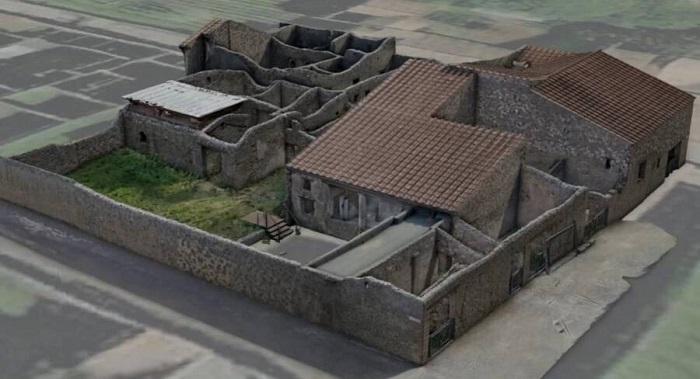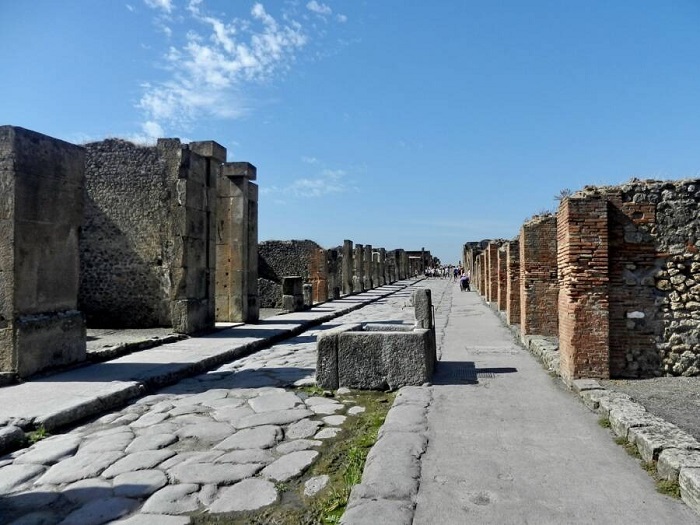A recent excavation in Pompeii has revealed the remains of a mat-making workshop near a restaurant that may have served elite diners.

Before the eruption of Mount Vesuvius destroyed Pompeii in 79 C.E., people in the city lived normal lives. They had jobs, decorated their homes, and went out to eat. Evidence of this chilling normality before disaster struck was just unearthed during recent excavations in the doomed city, which revealed both a mat-making workshop and a restaurant.
This discovery offers a hint at the artisanal and economic activity in Pompeii before the city was consumed in a deadly mix of hot gas and volcanic mud.
‘Mustard, Dill, And Mint’: Uncovering The Ancient Restaurant
According to a statement from Pompeii Archaeological Park, the recent discoveries were made during excavations in Zones D and E of building complex I 14, 1/11–14, during a collaboration between Tulane University and Pompeii Archaeological Park that began in 2022.
The complex, which appears to date back to the Italian Bronze Age, was apparently used for many different purposes over the centuries. Some of its rooms appear to have once been part of a restaurant, which archaeologists believe provided “elite-style, reclined dining.” However, it probably served a surprising clientele.

“Ancient literature… makes clear that the social and political elite would avoid patronizing such spaces, which appealed to the lower classes,” Allison Emmerson of Tulane University, the director of the excavation project, explained to All That’s Interesting in an email.
She continued: “The restaurant is interesting for many reasons, not least its indication of a social group between ‘the rich’ and ‘the masses’ who could afford to treat themselves to a little luxury. Garbage recovered from the restaurant’s kitchen allow us to analyze foods served there. Our study is ongoing, but we can already see a wide variety of foods that included meat, seafood, and fruit, as well as flavor enhancers like mustard, dill, and mint.”
‘Vanishingly Rare’: Pompeii’s Mat-Making Workshop
The restaurant wasn’t the only surprising discovery made at the site. Archaeologists also uncovered the remains of an ancient mat-making workshop along the southern façade of the complex.
“The major clue was the presence of large quantities of reeds, bundled and ready to be worked, as well as completed reed mats,” Emmerson explained to All That’s Interesting. “Organic materials like these typically do not survive at Pompeii… In addition to the reeds and mats, we also uncovered a large basin that would be suitable for soaking and crushing reeds, the necessary stages of preparation preceding weaving.”

Though mat-making workshops like these were probably fairly common in the ancient world, Emmerson told All That’s Interesting that they are “vanishingly rare in the archaeological record.”
“[T]hey created products that rarely survive over long periods of time, and their permanent fixtures are relatively generic, making them difficult to recognize archaeologically,” she said. “In fact, only one other secure example is known from the entire Roman world, and it is located in a distinctive spot: in Pompeii, right next door to the workshop our team has just identified.”
This site includes “carbonized piles of reeds and branches (likely for basket-making)” which were carbonized when a fire broke out during the eruption of Mount Vesuvius.
Curiously, archaeologists also documented a faded election notice that had been painted alongside the complex which contains the name of a woman apparently involved in mat-making. “It was sponsored by a woman called Tegeticula, ‘Little Reed Mat,’” the statement explains.
The building complex has thus yielded discoveries large and small about life in Pompeii. It also tells a story about the city’s more ancient history.
Excavating The Building Complex Itself
According to the park statement, archaeologists have been working through the archaeological layers of the site and “reconstructing its pre-eruptive history piece by piece.” The story began for the archaeologists — and ended for the people of Pompeii — in the layer from 79 C.E.

Archaeologists have been able to trace the history of the site to its beginning in the Italian Bronze Age, which left evidence of “discernible human activity.” Experts have also determined that the southern side of the building complex began to “urbanize” in the second century B.C.E. and experienced even more intense growth in the first century B.C.E.
Much of the complex was devoted to commerce by the first century C.E., and Emmerson and her team are looking forward to learning more about “what the two workshops can tell us about neighborhood economies in Pompeii.”
As such, the discovery of the mat-making workshop and restaurant in Pompeii adds another piece to the larger puzzle of this destroyed city. Alongside other recent finds like the prison bakery and a new set of stunning frescoes, the mat-making workshop and restaurant speak to what everyday life in Pompeii was like.
At least until it all changed with the shattering eruption of Mount Vesuvius.
After reading about the mat-making workshop and restaurant unearthed in Pompeii, see how ancient graffiti in Pompeii showed just how raunchy the Romans could be. Or, see why ancient Romans drew penises on just about everything.

